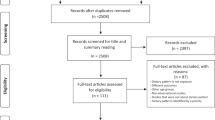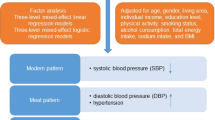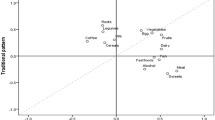Abstract
This study examined the association between dietary patterns, nutrition knowledge and lifestyle with blood pressure (BP) in a sample of Australian adults. Adults with normal and high BP were included in a cross-sectional study. Dietary intake data was collected using a Food Frequency Questionnaire. Nutrition knowledge and lifestyle surveys were included in the questionnaire. Dietary patterns were extracted using factor analysis followed by cluster analysis. Associations were analysed using logistic regression. Four hundred and seven participants were included. Three dietary patterns were identified: Western; Snack and alcohol; and Balanced. Participants with high BP had a higher intake of Western and a lower intake of Balanced dietary pattern. A significant and higher frequency of discretionary foods and oils consumption, as well as lower nutrition knowledge score and activity frequency, were observed in the high BP group. Regression analysis indicated that the intake of Western and Snack and alcohol dietary patterns increases the likelihood of having high BP by 2.40 (95% confidence interval (CI): 1.28–4.49) and 2.76 (95% CI: 1.52–5.00), respectively, when nutrition knowledge and lifestyle were controlled for as moderator variables. The likelihood of high BP was not associated with nutrition knowledge, but increased with physical inactivity. This study indicates that poor dietary patterns and inactivity are associated with increases in the likelihood of high BP, and the association is not influenced by nutrition knowledge. These findings indicate the importance of developing public health strategies with an emphasis on improving the dietary patterns of individuals to prevent and control high BP in Australian adults.
This is a preview of subscription content, access via your institution
Access options
Subscribe to this journal
Receive 12 digital issues and online access to articles
$119.00 per year
only $9.92 per issue
Buy this article
- Purchase on Springer Link
- Instant access to full article PDF
Prices may be subject to local taxes which are calculated during checkout

Similar content being viewed by others
References
World Health Organization. A Global Brief on Hypertension, Silent Killer, Global Public Health Crisis, 2014. Available at: http://apps.who.int/iris/bitstream/10665/79059/1/WHO_DCO_WHD_2013.2_eng.pdf (last accessed 17 July 2013).
Australian Bureau of Statistics. Australian Health Survey: Health Service Usage and Health Related Actions, 2011–12; 4364.0.55.002 2013. Available at: http://www.abs.gov.au/ausstats/abs@.nsf/Lookup/322DB1B539ACCC6CCA257B39000F316C?opendocument (last accessed October 2015).
Chobanian AV, Bakris GL, Black HR, Cushman WC, Green LA, Izzo JL et al. Seventh report of the joint national committee on prevention, detection, evaluation, and treatment of high blood pressure. Hypertension 2003; 426: 1206–1252.
Heidenreich PA, Trogdon JG, Khavjou OA, Butler J, Dracup K, Ezekowitz MD et al. Forecasting the future of cardiovascular disease in the United States: a policy statement from the American Heart Association. Circulation 2011; 1238: 933–944.
Sun J, Buys NJ, Hills AP . Dietary pattern and its association with the prevalence of obesity, hypertension and other cardiovascular risk factors among Chinese older adults. Int J Environ Res Public Health 2014; 114: 3956–3971.
Bailey RL, Mitchell DC, Miller CK, Still CD, Jensen GL, Tucker KL et al. A dietary screening questionnaire identifies dietary patterns in older adults. J Nutr 2007; 1372: 421–426.
Suliga E, Koziel D, Ciesla E, Gluszek S . Association between dietary patterns and metabolic syndrome in individuals with normal weight: a cross-sectional study. Nutr J 2015; 141: 55.
Deliens T, Clarys P, De Bourdeaudhuij I, Deforche B . Determinants of eating behaviour in university students: a qualitative study using focus group discussions. BMC Public Health 2014; 14: 53.
Hankonen N, Absetz P, Kinnunen M, Haukkala A, Jallinoja P . Toward identifying a broader range of social cognitive determinants of dietary intentions and behaviors. Appl Psychol Health Well Being 2013; 51: 118–135.
Wardle J, Parmenter K, Waller J . Nutrition knowledge and food intake. Appetite 2000; 343: 269–275.
Papathanasiou G, Zerva E, Zacharis I, Papandreou M, Papageorgiou E, Tzima C et al. Association of high blood pressure with body mass index, smoking and physical activity in healthy young adults. Open Cardiovasc Med J 2015; 9: 5–17.
Ryan P, Sawin KJ . The Individual and Family Self-management Theory: background and perspectives on context, process, and outcomes. Nurs Outlook 2009; 574: 217–25 e6.
Bandura A . Self-Efficacy: The Exercise of Control. W. H. Freeman, NY, USA, 1997.
Bandura A . Social Foundations of Thought and Action: A Social Cognitive Theory. Prentice-Hall: Englewood Cliffs, NJ, USA, 1986.
Baranowski T, Cullen KW, Nicklas T, Thompson D, Baranowski J . Are current health behavioral change models helpful in guiding prevention of weight gain efforts? Obes Res 2003; 11S10: 23S–43S.
Smith W, Mitchell P, Reay EM, Webb K, Harvey PW . Validity and reproducibility of a self-administered food frequency questionnaire in older people. Aust NZ J Public Health 1998; 224: 456–463.
Flood VM, Smith WT, Webb KL, Mitchell P . Issues in assessing the validity of nutrient data obtained from a food-frequency questionnaire: folate and vitamin B12 examples. Public Health Nutr 2004; 76: 751–756.
Barclay AW, Flood VM, Brand-Miller JC, Mitchell P . Validity of carbohydrate, glycaemic index and glycaemic load data obtained using a semi-quantitative food-frequency questionnaire. Public Health Nutr 2008; 116: 573–580.
Hendrie GA, Coveney J, Cox D . Exploring nutrition knowledge and the demographic variation in knowledge levels in an Australian community sample. Public Health Nutr 2008; 1112: 1365–1371.
Sallis JF, Pinski RB, Grossman RM, Patterson TL, Nader PR . The development of self-efficacy scales for healthrelated diet and exercise behaviors. Health Educ Res 1988; 33: 283–292.
Charan J, Biswas T . How to calculate sample size for different study designs in medical research? Indian J Psychol Med 2013; 352: 121.
Sun J, Buys NJ, Hills AP . Dietary pattern and its association with the prevalence of obesity, hypertension and other cardiovascular risk factors among Chinese older adults. Int J Env Res Public Health 2014; 114: 3956–3971.
Victora CG, Huttly SR, Fuchs SC, Olinto M . The role of conceptual frameworks in epidemiological analysis: a hierarchical approach. Int J Epidemiol 1997; 261: 224–227.
Huh JH, Lim JS, Lee MY, Chung CH, Shin JY . Gender-specific association between urinary sodium excretion and body composition: analysis of the 2008–2010 Korean National Health and Nutrition Examination Surveys. Metabolism 2015; 647: 837–844.
Bibbins-Domingo K, Chertow GM, Coxson PG, Moran A, Lightwood JM, Pletcher MJ et al. Projected effect of dietary salt reductions on future cardiovascular disease. N Engl J Med 2010; 3627: 590–599.
Aburto NJ, Ziolkovska A, Hooper L, Elliott P, Cappuccio FP, Meerpohl JJ . Effect of lower sodium intake on health: systematic review and meta-analyses. BMJ 2013; 346: f1326.
Dietary fats, dietary cholesterol and heart health. Q & A. Heart Foundation Australia [Internet]. 2009. Available at: https://www.heartfoundation.org.au/SiteCollectionDocuments/Dietary-Fats-Dietary-Cholesterol-and-Heart-Health.pdf (last accessed October 2015).
Oh K, Hu FB, Manson JE, Stampfer MJ, Willett WC . Dietary fat intake and risk of coronary heart disease in women: 20 years of follow-up of the nurses' health study. Am J Epidemiol 2005; 1617: 672–679.
Djoussé L, Pankow JS, Hunt SC, Heiss G, Province MA, Kabagambe EK et al. Influence of saturated fat and linolenic acid on the association between intake of dairy products and blood pressure. Hypertension 2006; 482: 335–341.
Valensi P . Hypertension, single sugars and fatty acids. J Hum Hypertens 2005; 19 (Suppl 3): S5–S9.
Geaney F, Fitzgerald S, Harrington J, Kelly C, Greiner B, Perry I . Nutrition knowledge, diet quality and hypertension in a working population. Prev Med Rep 2015; 2: 105–113.
Land MA, Webster J, Christoforou A, Johnson C, Trevena H, Hodgins F et al. The association of knowledge, attitudes and behaviours related to salt with 24-hour urinary sodium excretion. Int J Behav Nutr Phys Act 2014; 111: 47.
Contento IR . Nutrition education: linking research, theory, and practice. Asia Pac J Clin Nutr 2008; 17 (Suppl 1): 176–179.
Bohn B, Herbst A, Pfeifer M, Krakow D, Zimny S, Kopp F et al. Impact of physical activity on glycemic control and prevalence of cardiovascular risk factors in adults with type 1 diabetes: a cross-sectional multicenter study of 18,028 Patients. Diabetes Care 2015; 38 (8): 1536–1543.
Cade JE, Burley VJ, Warm DL, Thompson RL, Margetts BM . Food-frequency questionnaires: a review of their design, validation and utilisation. Nutr Res Rev 2004; 171: 5–22.
Acknowledgements
We acknowledge the valuable support of the Gold Coast City Council, Gold Coast University Hospital, Griffith University and all individuals who assisted with data collection, and participated in this study.
Author information
Authors and Affiliations
Corresponding author
Ethics declarations
Competing interests
The authors declare no conflict of interest.
Rights and permissions
About this article
Cite this article
Khalesi, S., Sharma, S., Irwin, C. et al. Dietary patterns, nutrition knowledge and lifestyle: associations with blood pressure in a sample of Australian adults (the Food BP study). J Hum Hypertens 30, 581–590 (2016). https://doi.org/10.1038/jhh.2016.22
Received:
Revised:
Accepted:
Published:
Issue Date:
DOI: https://doi.org/10.1038/jhh.2016.22
This article is cited by
-
Status of household dietary diversity and associated factors among rural and urban households of Northern Uganda
BMC Nutrition (2023)
-
The association between self-efficacy and self-care in essential hypertension: a systematic review
BMC Family Practice (2021)
-
Associations between dietary patterns and blood pressure in a sample of Australian adults
Nutrition Journal (2020)
-
Effect of 8-weeks prebiotics/probiotics supplementation on alcohol metabolism and blood biomarkers of healthy adults: a pilot study
European Journal of Nutrition (2018)
-
Dietary Patterns, Nutrition Knowledge, Lifestyle, and Health-Related Quality of Life: Associations with Anti-Hypertension Medication Adherence in a Sample of Australian Adults
High Blood Pressure & Cardiovascular Prevention (2017)



